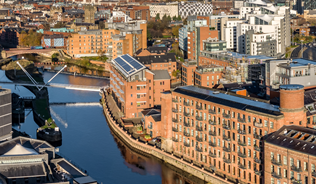Listen to more episodes of 'From the Archive' on the series hub.
The way we interact with transport in our urban areas is set to dramatically change over the coming decades. Cities are already seeing the changes with new transport options like scooters, electric vehicles and hire bikes. The introduction of new mobility options, disruptive technology concepts such as mobility as a service (MaaS) and changing trends in travel and vehicle ownership will all affect our cities.
With the increasing focus on climate change in the media and the growing awareness of our collective impact on the earth’s climate, now is the time to consider what the potential consequences of future mobility will be on the environment. There have been too many examples where the status quo or a new policy has unwittingly brought about environmental harm. For example, the UK policy to promote diesel vehicles over petrol helped to reduce CO2 emissions but significantly worsened local air pollution. Planning for the future needs careful consideration and it is important to recognise now how new mobility can be used to the greatest benefit for improving our local and global environment.
Much has been made of the potential for carbon reductions and air quality improvements with a shift to renewably powered electric vehicles. This is certainly an opportunity area and it is one which could plausibly succeed with current expected consumer and business trends in place. However, there are many other areas where future mobility could provide improvements to the environment. One of the key opportunities is to consider the material intensity (how much natural resources are required) of new mobility. Applying the concept of circular economy will provide environmental benefits at a global level, by reducing resource and waste. Arup, as a knowledge partner to leading circular economy research group the Ellen MacArthur Foundation (EMF), is well placed to advise on how to get the most from this concept. The circular economy concept, which once seemed too utopian in its ambitions, is now seen as a viable roadmap out of the climate and environmental crisis.
Consider the example of even simple transport options such as scooters, which rocketed to popularity in US cities in 2019. The scooters were found to have a much lower lifespan than was originally expected, with average street use time of just three months. Using new materials, modular assembly and additive manufacturing can reduce raw material requirements and support the localisation of production, which can in turn shorten the supply chain. These lessons are being learned fast, as new mobility options and new markets are rapidly introduced to cities with connected digital technology.
Larger, more resource intensive technologies such as autonomous cars and buses are being developed. Manufacturers and developers such as Waymo (the developer of level four automation with the greatest test mileage) need to learn from the lessons of the existing car market, and those being learnt now by other disruptive technologies such as scooters. It is expected that autonomous cars will be fleet operated rather than individually owned. This lends itself very well to embracing circular economy concepts because it will be easier to take a low resource modular approach to fix issues, whereby each car could be the same build and specification and could be built with easily replaceable parts.
Developers and planners of proposed schemes should keep in mind the opportunities which will come with new mobility options. Falling car ownership and autonomous fleets are expected to reduce the need for parking, freeing up space on our roads and in our cities. There will be greater room for walking and cycling, sustainable drainage systems and parks. All of this will lead to health and wellbeing and environmental benefits such as better air quality, reduced noise and more biodiversity.
To provide some examples of future proofing developments, there are already car parks being converted to office or housing space. Future developments need to consider how they should plan for the long term, by designing buildings that can be converted once parking space is no longer needed. This links back to the concept of circular economy because it will be important to design now with materials that can be easily replaced and reused.
Another example is the opportunity for improved biodiversity. Imagine that instead of a swathe of concrete for parking there was a nice green space. With the reduction in car ownership we can consider converting disused spaces into community assets which will support local biodiversity.
These are just some examples of the environmental benefits which new mobility and autonomous transport can bring to cities. By planning now, there is a massive opportunity to use the changing nature of our urban transport options to improve our local and global environment.
James Bellinger is a Chartered Environmentalist with over 10 years’ experience in leading air quality assessments in the UK and overseas. James manages air quality and odour assessments for a range of clients and across a wide range of spatial scales, from small developments to the city scale. James has a particular interest in mitigation options for air quality and works with clients and stakeholders to identify solutions which will provide suitable mitigation to local air quality issues.





